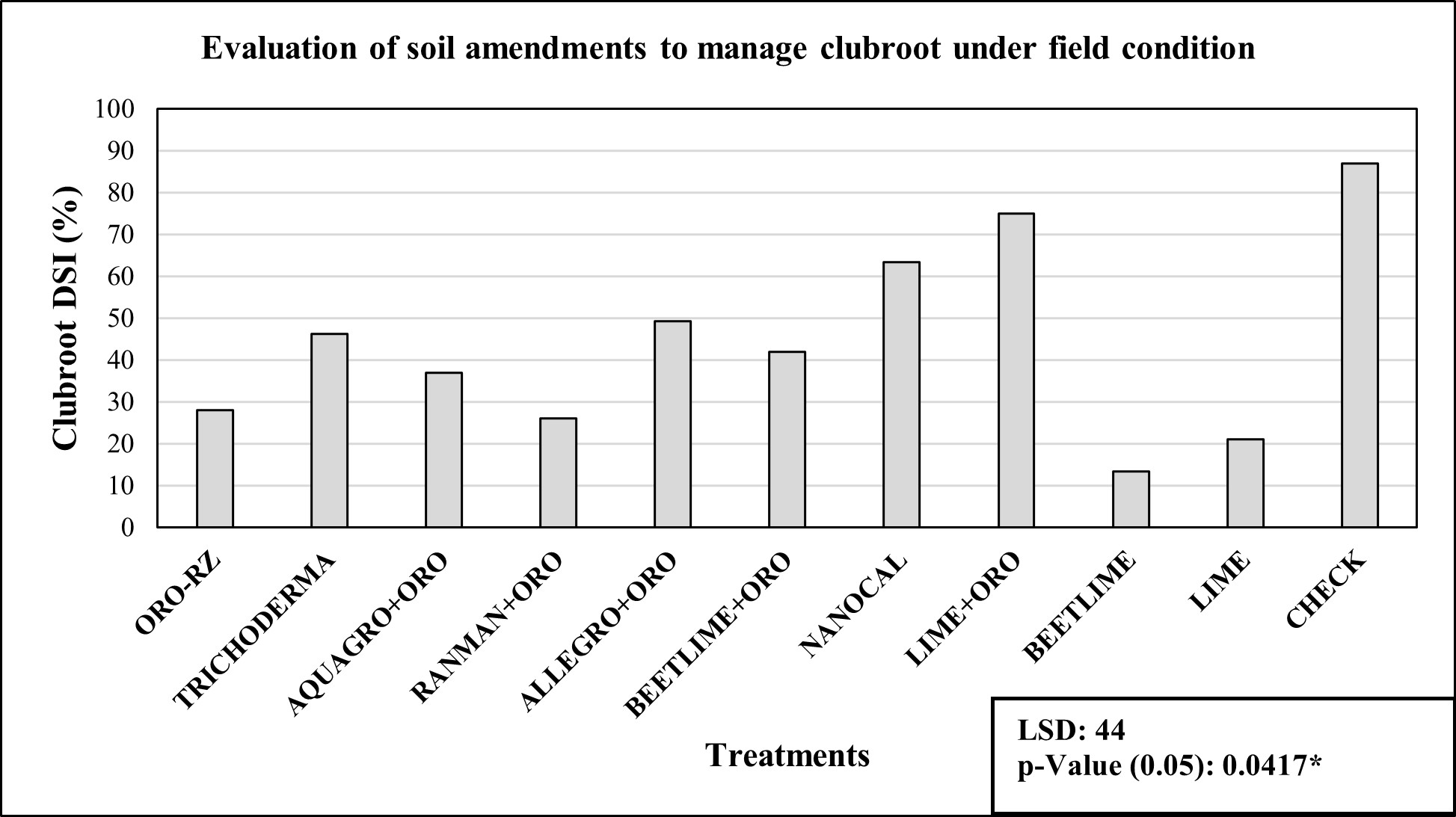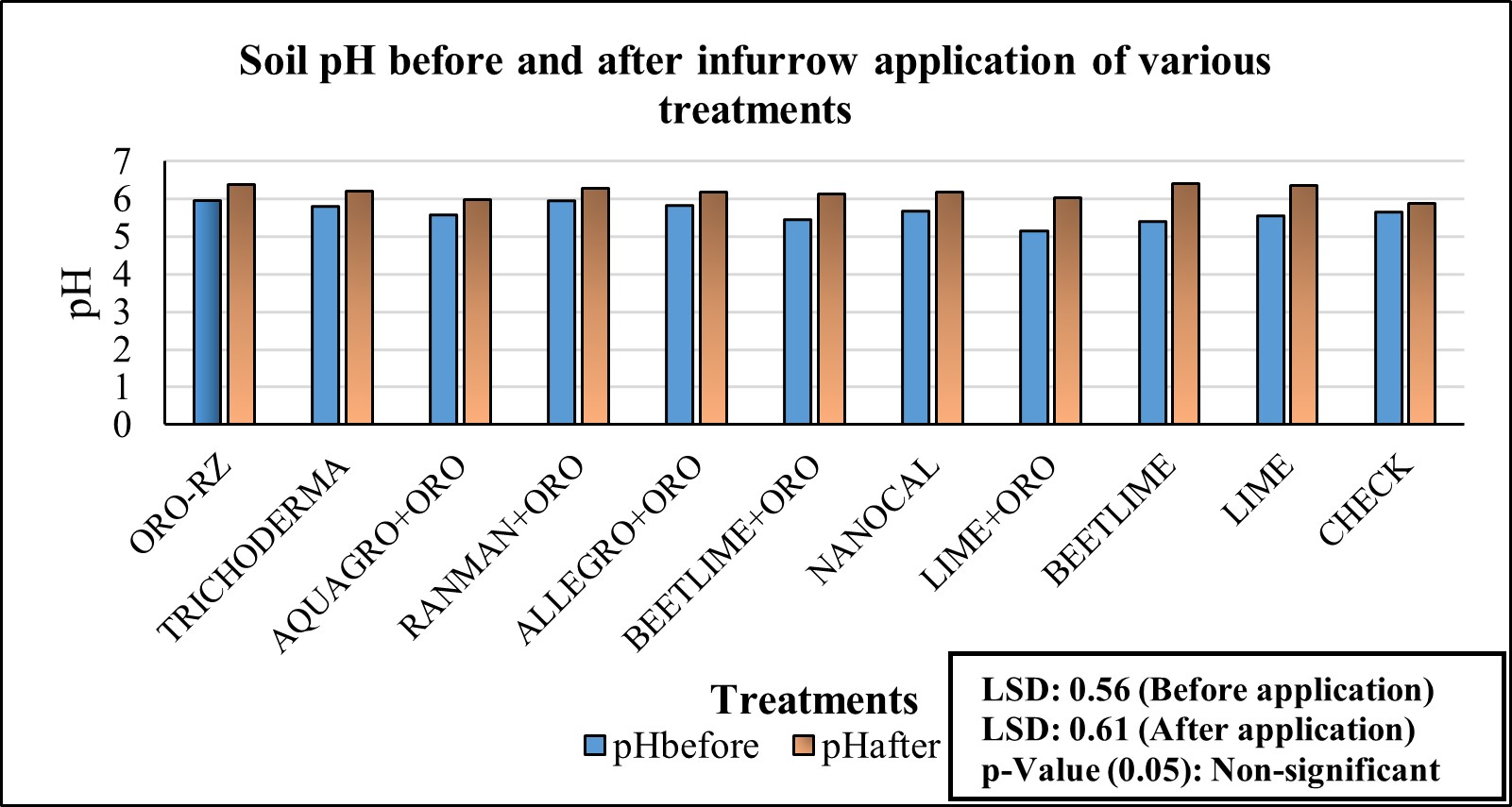Objective: Effect of surfactant (ORO-RZ) alone, fungicides along with a surfactant, and various types of lime alone and along with surfactant to manage clubroot on canola in patches.
Methods: The following treatments (Table 1) were tested alone and along with a surfactant (ORO-RZ®) in a Randomized Complete Block Design, replicated four times under field conditions. The field has natural soil population of P. brassicae of 5.5 million resting spores/g of soil. Treatments of ORO-RZ, Aquagro, Ranman, allegro, nanocal, and Trichoderma were applied in-furrow just before planting at the rate mentioned in Table 1. Whereas, lime and beet lime were incorporated at a depth of 4-6 inches a week before planting. The canola seed of “DKL 30-42” (susceptible cultivar to clubroot) was planted at a depth of one half inch. Beet lime was acquired from American Crystal Sugar Factory, Drayton, ND. Whereas, lime was acquired from the Langdon land fill (a by-product of lime sludge and remains from the Langdon water plant). The trial was planted in the first week of June and evaluated the first week of August (exactly 60 days after planting) at growth stage BBCH-65.
Rating scale: Clubroot rating scale: 0 = no galling, 1 = a few small galls (small galls on less than 1/3 of roots), 2 = moderate galling (small to medium-sized galls on 1/3 to 2/3 of roots), 3 = severe galling (medium to large-sized galls on more than 2/3 of roots) (S.E. Strelkov). The rating scale was used for disease rating of incidence and severity. A Clubroot Disease Severity Index (CRDSI) was calculated using the incidence and severity data of clubroot obtained.
Soil sampling to determine pH: Soil samples were collected from all the plots before application of soil treatments and on the day of clubroot evaluations to know the effect of unit change in pH and their impact on clubroot control.
Table 1: Effect of treatments applied in-furrow before planting on clubroot disease severity index (DSI %), and the change in soil pH before and after the application.
Name | Rate | Clubroot DSI (%) | pH before | pH after |
|---|
ORO-RZ | 2 pt/a | 28 | 5.95 | 6.38 |
TRICHODERMA | 10.5 oz/a | 46.3 | 5.8 | 6.2 |
AQUAGRO + ORO-RZ | 10 g/meter of row | 37 | 5.58 | 5.98 |
RANMAN + ORO-RZ | 7.5 l/ha | 26 | 5.95 | 6.28 |
ALLEGRO + ORO-RZ | 1.75 l/ha | 49.3 | 5.83 | 6.18 |
BEET LIME + ORO-RZ | 7.5 tons/ha | 42 | 5.45 | 6.13 |
NANOCAL | 4 pt/a | 63.3 | 5.68 | 6.18 |
LIME + ORO-RZ | 7.5 tons/ha | 75 | 5.15 | 6.03 |
BEET LIME | 7.5 tons/ha | 13.3 | 5.4 | 6.4 |
LIME | 7.5 tons/ha | 21 | 5.55 | 6.35 |
CHECK | CHK | 87 | 5.65 | 5.88 |
| | MEAN | 44 | 5.6 | 6.2 |
| | CV% | 69 | 6.93 | 6.86 |
| | LSD | 44 | NS | NS |
| p-Value (0.05) | 0.0417* | NS | NS |
Results: Beet lime when used alone has lower clubroot disease severity index (13%) followed by solo treatment of lime (21%), combination treatment of fungicide Ranman + ORO-RZ (26%) and solo treatment of the surfactant ORO-RZ (28%) (Table 1, Figure 1). Statistically, there were no significant differences observed in pH among the treatments tested before and after application, however, beet lime had a one unit increase in soil pH and lime had a 0.8-unit increase after application. As the results look promising, we will continue the research onto the second year.
Figure 1: Graphical representation of clubroot management of various soil treatments.
Figure 2: Graphical representation of the change in soil pH due to application of various soil treatments.
Acknowledgments: Funding from the Northern Canola Growers Association and North Dakota Crop Protection Product Harmonization Board, and thanks to all the product suppliers. Special thanks to Intern Mr. Jacob Kram (NDSU).

